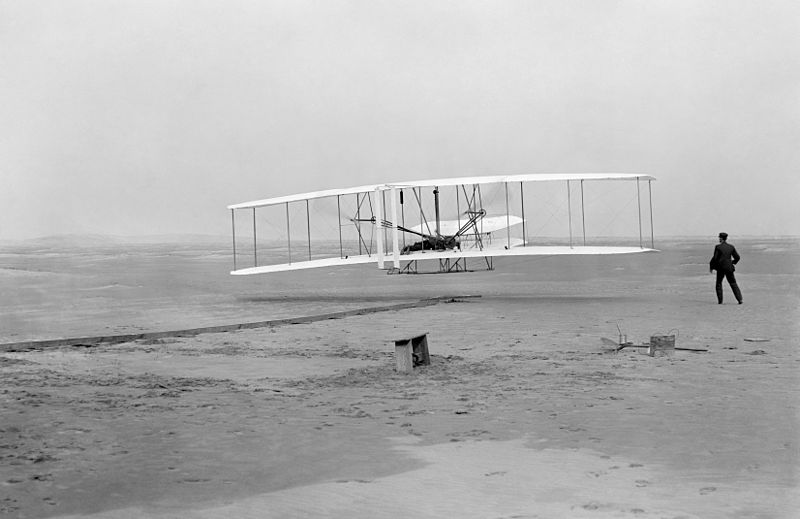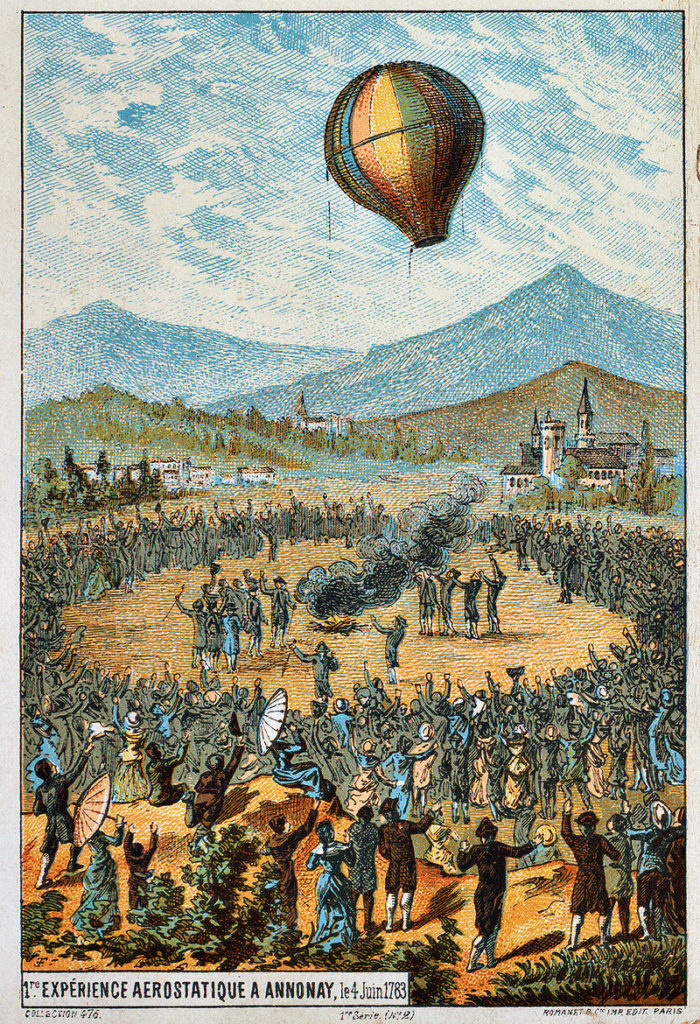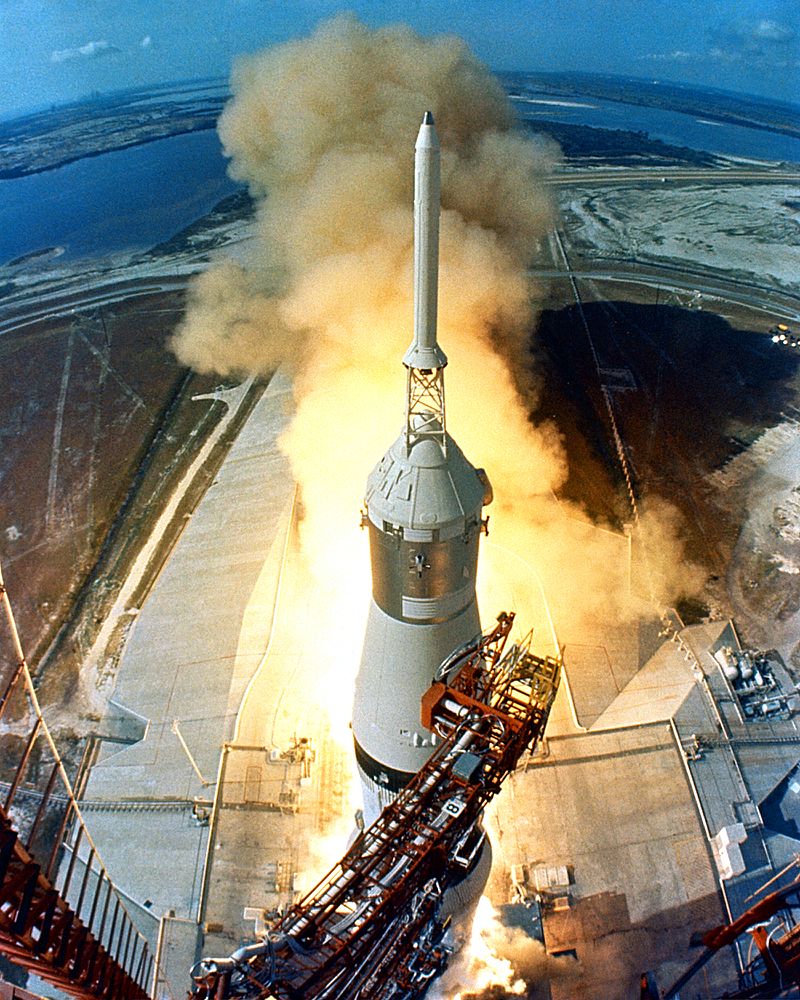The entire flight lasted only twelve seconds. The consequences will last for all of human civilization. On December 17, 1903 just outside Kitty Hawk, North Carolina, Orville and Wilbur Wright completed the first successful sustained and controlled heavier-than-air, powered flight.

Flight Before the Airplane

Flight had been attempted long before the Wright Brothers success. People have always dreamed of soaring with the birds. Flying kites have been used in China dating to hundreds of years BCE. Renaissance artist and inventor Leonardo Da Vinci famously sketched but never constructed flying designs in his notebook. The earliest successful attempts at flight were conducted by lighter than air balloons and winged gliders.
The first hot air balloon flight was demonstrated in June 1783 by French brothers Jacques-Etienne and Joseph-Michel Montgolfier. Three months later another of their balloons carried the first living beings into the air – a sheep, a duck, and a rooster. Then on November 21, 1783 the first manned hot air balloon flight took place. The flight carried a doctor and an army office a distance of six miles over Paris, France.
Earlier gliders were the first heavier than air, unpowered flyers. It required the pilot to launch himself into wind from an elevated location. The special shape of the wing provided lift to keep the glider in flight. The first successful gliding flight occurred in 1849 and was based on the design of Sir George Cayley. The most influential figure in gliding was Otto Lilienthal. From 1981-1986 he performed over 2000 successful flights testing out different gliding designs. His fame influenced many others to experiment with flight, including the Wright Brothers.
Enter the Wright Flyer
In order to achieve flight a device must produce more lift than its weight. Balloons achieve this through being less dense than the air around them. Gliders use specially shaped wings to glide through the air. Their drawback is they lack a source of thrust needed for sustained flight.
The Wright Brother initially experimented with gliders so that they could master flight balancing and control while continually improving their design. From 1900-1902 the Wright Brothers constructed and tested various glider designs at Kitty Hawk. They initially struggled with producing enough lift in the gliders. Their gliders were only producing about 1/3 of the calculated lift when derived from the established equation of lift. This led the brothers to question the value of the Smeaton coefficient in the equation which determined the value of air pressure. They collected their own aerodynamical data and determined the value of Smeatons coefficient to be close to 0.0033, different from the accepted value of 0.0054. With more accurate data they were now better able to construct more reliable designs.
In 1902, armed with more accurate data they decided to build one more glider before attempting to build a powered airplane. Improvements were made to the rudders and control system. Between September and October they made over 500 successful flights, some to a height of 600 feet. They were now ready to construct their airplane.
The constructed airplane had to account for the added weight of the 200 pound propulsion system. This required an increased wing area to over 500 square feet, along with other improvements in wing design to increase lift. They constructed their own, crude engine, made of lightweight aluminum capable of producing twelve horsepower. They used a chain and sprocket transmission system, one similar to a bicycle, to transmit the energy from the engine to the propellers.
In late 1903 the brothers returned to Kitty Hawk to test out their airplane. They chose the name Wright Flyer for their plane. They conducted four successful flights on December 17, 1903. The longest covered a span of 859 feet and lasted 59 seconds.
The World Takes Flight

(Credit: Wikimedia Commons)
The success of the Wright Brothers was initially met with much skepticism, but they soon showed the way for many others to follow. In 1909 Louis Bleriot flew across the English Channel, a distance of 25 miles. Charles Lindberg traversed 3,000 miles across the Atlantic Ocean in 1927.
The jet engine, first produced in 1939 in Germany, was another significant milestone in flight. The jet engine allowed aircraft to fly higher where the air is thinner and drag is reduced. Soon flight had revolutionize the world, both in military and commercial contexts. Air superiority played a key world in the outcome of WWII. It was only a few more decades before man was walking on the moon. The Voyager Space Program has two probes outside of our solar system. Flight technology will play a pivotal role in humanity’s next frontier: space exploration.
Continue reading more about the exciting history of science!
Very informative post! I didn’t know air balloons are that old!
I love aviation history! What a fun post, thank you!
I’ve never heard this before but I’ve learned something about aviation history. Thanks for sharing.
How fun is this! I’ve always wanted to learn more about airplanes and their history.
I love reading about aviation history. It’s so fascinating to me how we were able to develop flight!
It’s crazy to think about how far we’ve come in such a short period of time (relatively speaking). Really makes you marvel at human ingenuity .
What a fascinating history. I love flying and everything about aeronautics so it was great to learn more.
Wow, this sounds so interesting! I have learned so much from this post so thanks for sharing aeroplane’s history with us ☺
How fascinating! It’s an amazing accomplishment – so it’s super interesting to see the process of how flying came to be!
What a fascinating read!we’ve definitely come a long way from hot air balloons. Next thing we know, well commute to work via buses in the sky!